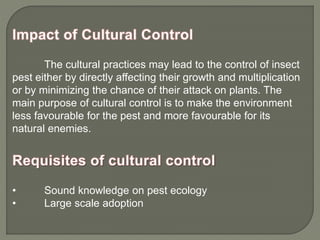Not known Details About Pestwise
Pestwise - Questions
Table of ContentsFacts About Pestwise UncoveredLittle Known Facts About Pestwise.An Unbiased View of PestwiseHow Pestwise can Save You Time, Stress, and Money.The Best Guide To PestwiseThe Facts About Pestwise RevealedThe 3-Minute Rule for Pestwise

Q. Specify "integrated parasite monitoring" (IPM) and checklist a number of feasible control techniques that may be made use of in an IPM method. A. Integrated insect monitoring is the integrating of appropriate insect control tactics right into a single strategy to decrease pests and their damages to an acceptable degree. Pest control methods may consist of: host resistance, biological control, social control, mechanical control, sanitation, and chemical (chemical) control.
Pestwise Fundamentals Explained
What can you do to keep the insects you are attempting to control from ending up being immune to the chemicals you utilize? A. Insect resistance can be lowered by utilizing integrated bug monitoring and rotating the sorts of chemicals made use of.
Parasites are a critical danger to the farming organization, and incorporated pest management helps farmers address and mitigate these dangers. Integrated bug administration uses numerous techniques in facility, hence being an extra reliable solution to the issue. Bed Bug Treatment. In certain, removing hostile chemical methods allows for reducing injury to individuals and the setting by making use of all-natural and more secure alternatives rather
3 Easy Facts About Pestwise Explained
The goal of incorporated insect management is to minimize this injury and control appropriate infestation degrees instead than eliminate all unwanted populations. This is why it is vital to comprehend what measures are warranted in each instance and use hostile ones only when various other incorporated monitoring techniques do not work. Integrated management mitigates the adverse consequences of a non-IPM method, and the main benefits of IPM Perks of IPM.
An appropriate understanding of the problem scope determines if the trouble must be dealt with. are the next parts of an IPM program since it is essential to understand if the organisms make possible risks and make a decision on the integrated monitoring choices or the certain pesticide use. mean to reduce problems by using different agronomic strategies.
The 4-Minute Rule for Pestwise
Integrated monitoring alternatives in an IPM program begin with much safer to a lot more aggressive ones. The above-mentioned incorporated management aspects help recognize just how to prepare and execute an IPM program step by step: Display your plants consistently.

Among others, IPM social techniques consist of the following area monitoring techniques: dirt therapy; selection of appropriate plants; plant turning; interplanting or strip cropping; option of growing days; weed control; use of trap plants. Beneficial dirt conditions speed up plant growth, and energetic plants are much more resistant to infestations. Healthy plants and seeds predetermine effective plant growth, so it is essential to select pest-free growing product with solid roots.
Therefore, amongst other applications, crop rotation can be efficiently utilized as an incorporated parasite management technique. Pests spread slower if rows of various plant kinds divide their host plants in intercropping or strip chopping, which is also utilized in the incorporated parasite monitoring system. Conversely, infestations enhance when plants of the very same plant kind or family members expand with each other.
Potato beetles can hurt growing potatoes, in addition to recommended you read tomatoes. Planting trap plants in spots is an additional alternative for IPM intercropping. This incorporated bug management method recommends bring in parasites to details plants and after that regulating them with chemical or mechanical strategies. In certain, you can expand soybeans as trap crops for Japanese beetles.
7 Easy Facts About Pestwise Shown
Barriers are regular examples of physical IPM techniques. Mature pests or their eggs and larvae are gathered by hand and damaged.

Division of Plant Sciences. This incorporated monitoring technique suggests an usual way of ruining pests by predators, parasitoids, virus, and various other organic control agents (aka antagonistic microorganisms). The function of organic control in IPM is to.
Some Known Questions About Pestwise.
With time, their population transformed out to be a real nuisance to farmers alongside indigenous kangaroos or dingoes. The cane toad is an additional case illustrating incorporated organic control failure in this regard when it refused to quest the target species and came to be a parasite itself. Parasitoids create on or within their hosts to at some point kill them after maturing.